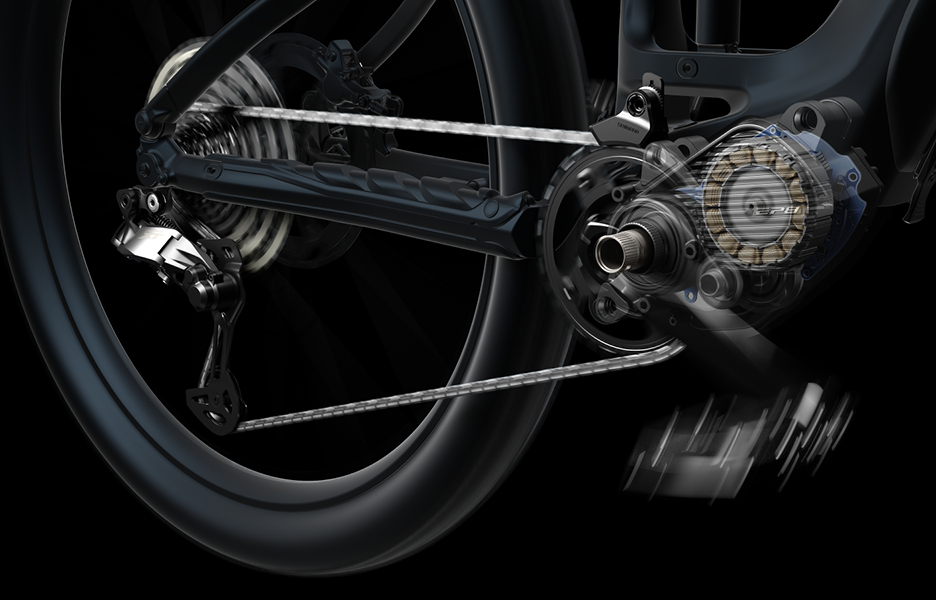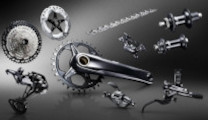Our AUTO SHIFT technology marks one of the biggest ever steps forward in cycling innovation. The concept of automated shifting has become a reality. The technology certainly delivers, but how does it work in a practical, real-world sense? And what are its benefits to you?
Let’s take a look.
But first, a refresher on the what’s what.
AUTO SHIFT is an innovative sensor technology that monitors your riding to measure cadence, torque and speed to move you into the best gear for the conditions seamlessly.
FREE SHIFT delivers pedal-free gear shifting by synchronizing the chainring rotation with the rear derailleur. This enables gear changes while coasting.
You can use AUTO SHIFT and FREE SHIFT if you have a setup with either an EP801 or EP600 drive unit and DEORE XT Di2 or SHIMANO CUES Di2.
Designed for happy riding
Particularly for recreational cyclists and commuters, automatic shifting is ideal.
You pedal, and the system always finds the perfect gear automatically. When you shift more regularly, the strain on your chain is reduced, making it last longer. A pleasant side effect is that you can concentrate on the beautiful landscape while minding the traffic. In short, reduced wear and tear meets more riding enjoyment.
AUTO SHIFT and FREE SHIFT also improve your everyday comfort. Nearing a traffic light? No problem! Let the bike coast when the lights change from green to red. The system will automatically shift to the set minimum gear, and when the light turns green, you can set off again without breaking a sweat.
This may sound a little complicated at first, but it can make everyday and leisure cycling much easier.

Explaining automatic shifting technology
Our state-of-the-art technologies AUTO SHIFT and FREE SHIFT are available for e-bikes equipped with EP600 or EP801 drive units, because only state-of-the-art electronics make all this possible.
We’ve outfitted the system with a range of sensors that record data from the pedal, crank and motor in real time to analyze which gear is the perfect choice for the current situation. At Shimano, we believe everything works best when it comes from a single source: the components work best when they seamlessly interact with each other.
The system works so that three sensors transmit their data in real-time to the motor, which is the brain behind the technology. It doesn't work without an electric drive. How fast you are riding, how often you pedal (the cadence) and how much pressure is applied to the pedals is continuously transmitted.
That means the system consists of three sensors:
- Speed sensor
- Cadence sensor
- Torque sensor
For example, if the pressure on the pedal decreases, the speed is reduced, and you no longer pedal as much, then you are probably riding in a higher gear than you should be. The system will automatically recognize this and shift to a suitable sprocket.
The aim of automatic shifting is to always be in the right gear. Efficiency is the top priority. This doesn’t just benefit the rider. It also has a positive effect on the range and durability of the components.

What is FREE SHIFT all about?
FREE SHIFT comes with two options:
- Manual FREE SHIFT
- Automatic FREE SHIFT or simply AUTO FREE SHIFT
We’ve tested this system with many different cyclists, making it as intuitive as possible. Here’s how it works:
While freewheeling, you can operate the gearshift by hand and shift to the gear that suits you best. That’s manual FREE SHIFT. However, you can also leave the shifting to the automatic system. For example, when coasting towards a traffic light, you do not shift gears yourself. Just leave the shifting to the automatic system. This is called AUTO FREE SHIFT.
FREE SHIFT means that you can shift gears anytime, it doesn’t mean you have to. With this technology, the chainring and pedals are not attached to each other. When you shift gears, the chainring turns, but not the pedals. While the pedals remain stationary, the chainring continues to be driven by the motor.
Despite automatic shifting, you can still shift manually. You can always override the automatic gearshift. You can also disable automatic shifting completely. Leaving you with an e-bike with electronic shifting and the freedom to ride as you normally would.

Natural riding feeling on an e-bike
At Shimano, we pride ourselves on creating a natural riding experience. That’s also what we’re going for regarding AUTO SHIFT and FREE SHIFT, with harmonious power delivery from the motor and the power you generate yourself.
In concrete terms, this means that even technically experienced or sensitive riders can ride an e-bike without compromising on riding enjoyment. Everything works to keep you in touch with nature and your surroundings—rather than detaching you from this experience.
Explaining E-TUBE
All bikes with AUTO SHIFT and FREE SHIFT come with sophisticated basic settings from the manufacturer. The SHIMANO E-TUBE PROJECT Cyclist App is a big recommendation for anyone who wants to get to grips with the system more intensively. Many settings for the e-bike can be customized here. This also applies to the AUTO SHIFT and FREE SHIFT settings.
First of all, it is important to know that the system has two automatic modes and one manual mode. These can even be changed while cycling. You don't have to take your smartphone out of your pocket to do this. You can configure exactly how the bike behaves in each mode via the app and set your preferred setup on your bike computer.
For instance, a battery-saving mode can be configured for daily rides to work and another for recreational rides during the weekend. This makes it easy to switch between the two automatic modes.


With the E-TUBE app, you can fully customize the system to your personal preferences, but even without further settings, the new technologies make cycling more comfortable. And, of course, if you prefer to shift gears yourself, you can do so at any time with AUTO SHIFT and FREE SHIFT!
Although it may seem complicated at first: AUTO SHIFT & FREE SHIFT are technologies that make cycling easier and more intuitive. Our tip: Go to the bike store and ask for a test ride.
Share This Article





